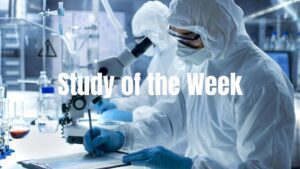Welcome to Study of the Week from Patient Worthy. In this segment, we select a study we posted about from the previous week that we think is of particular interest or importance and go more in-depth. In this story we will talk about the details of the study and explain why it’s important, who will be impacted, and more.
If you read our short form research stories and find yourself wanting to learn more, you’ve come to the right place.

This week’s study is…
Personalized chordoma organoids for drug discovery studies
We previously published about this research in a story titled “Chordoma Organoid Models Could Improve Drug Discovery” which can be found here. The study was originally published in the journal BMC Cancer. You can view the full text of the study here.
This research team was affiliated with the University of California – Los Angeles Health Sciences.
What Happened?
Chordoma is a very rare type of cancer that can appear along the spine or the base of the skull. The disease is so rare that running clinical trials to test possible treatments has been very difficult. Organoids are lab-grown masses of cells that are grown in a lab and used for research. These can be derived from the cells of internal organs or, in this case, rare cancer tumors. In this study, scientists, sought to develop organoids from chordoma tumors so that they can be used for drug development research.
In this study, the researchers were able to extract seven samples of cancer cells from five different patients living with the disease. These tumors represented chordoma that was at different stages of development and were also located at distinct sites. The organoids developed from these tumors were able to recapitulate features of the original tumors, such as expressing proteins associated with chordoma, including Ki-67 and brachyury.
After the organoids had been created, the scientists performed high throughput drug screenings. This is an automated process of drug discovery that allows for multiple potential therapies to be evaluated at the same time. This screening allowed the researchers to identify several potential drug targets that could be pursued for chordoma, such as STAT3, JAK2, EGFR, and PI3K/mTOR. The researchers noted that responses varied between the different organoids, highlighting the importance of personalized approaches for treating the disease effectively.
About Chordoma
Chordoma is a slow growing rare cancer that is thought to originate from the cells of the notochord. The tumor often appears at the base of the skull or along the spinal column. The precise of cause of this cancer is unknown. There are no known external risk factors for it. However, duplication of the brachyury protein appears to be a risk factor, and the presence of the cancer within certain families suggest that it could have a genetic component as well. Symptoms of chordoma include double vision, problems with bowel or bladder function, headaches, back pain, and numbness or weakness in the back, legs, or arms. While there are no treatments specifically approved for chordoma, surgery followed by radiation therapy is the most common approach. This cancer is somewhat resistant to radiation and requires heavy doses. To learn more about chordoma, click here.
Why Does it Matter?
In diseases that are as ultra-rare as this cancer, making progress in treatment is inherently more challenging due to the difficulty of locating patients to participate in trials. This can cause progress in drug development to grind to a halt almost completely. These are situations in which tools such as organoids, which can imitate the characteristics of the tissue it was derived from with remarkable accuracy, can make a major difference.
The development of organoids has been progressing at UCLA in the laboratory of Dr. Alice Soragni. Chordoma does not respond very well to treatment. It is almost totally non-responsive to chemotherapies, and also are strongly resistant to radiation therapy as well. The best chance a patient has is complete removal of the tumor with surgery, but this is not always possible depending on where it is located. If the tumor is not removed in its entirety, then the chance of recurrence is high. Therefore, developing new therapies is vital for patients that aren’t candidates for full surgical removal.
“There is a real need for clinically-relevant, personalized models to find therapeutics for chordoma and many other rare cancers…What we have done is to optimize a platform to grow organoids using cells from the tumors to be able to investigate their biological characteristics and determine which pathways might be most promising for treatment by testing them against a wide range of therapeutics.” – Alice Soragni, assistant professor, Department of Orthopedic Surgery
The team will continue its path of creating individualized organoids and other models for rare cancers and tumors, which often lack treatments. Meanwhile, other research should investigate some of the potential targets that the team was able to identify during its automated throughput screenings of the organoids.








